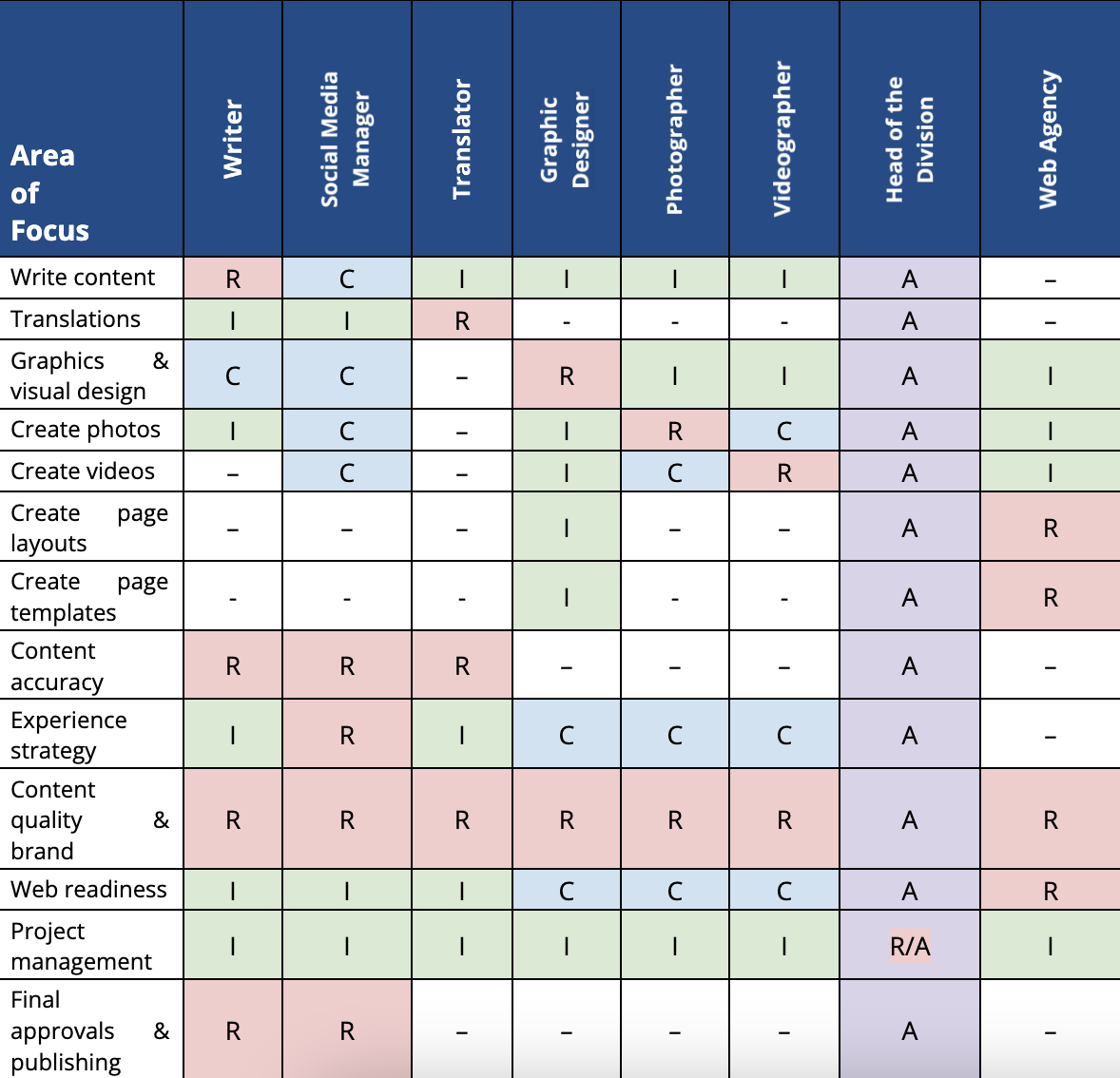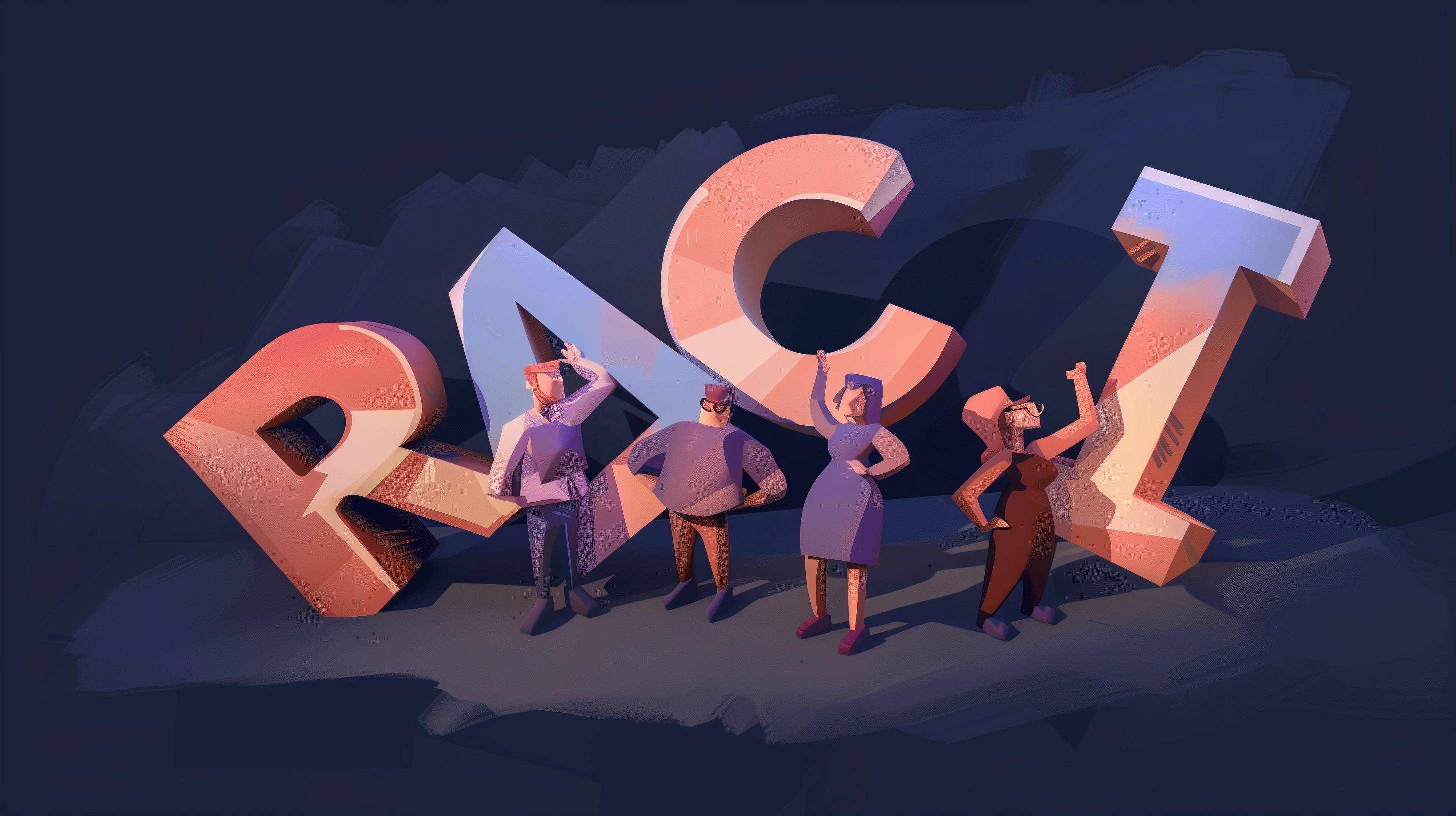Content development is rarely a one-person show. Behind each blog article, video, or social media post is a diverse team of creators, editors, graphic designers, SEO specialists, and more.
Imagine you're working on a new article for a blog. One person is drafting the post, another is working on graphics, someone else has to proofread it, and someone must give the final approval. Without proper role definition, tasks may fall through the cracks or get duplicated, leading to wasted time and effort.
This is precisely where the RACI Matrix shines. It helps to clearly define roles and responsibilities – ensuring everyone knows exactly what they should be doing – and aligns the team towards a shared goal.
Breaking down the RACI components #
Understanding the RACI Matrix is easy when you apply it to real-life scenarios. Let's break it down using real-life examples:
Responsible: The content creator, graphic designer, and SEO specialist usually fall into this category. They do the actual work of writing articles, designing graphics, inserting SEO keywords, and so forth. Essentially, they are the “do-ers”.
Accountable: These are typically your content manager or the person who gives a final nod before the content goes live. They may also be referred to as “the decider” because they have final approval on content decisions.
Consulted: This category includes all the individuals whose opinions or knowledge contribute to the content. For instance, subject-matter experts who provide insights into topics, or perhaps compliance specialists who ensure the legality of content. They can be internal team members or external contributors who provide value by giving their expert views.
Informed: These are people who don’t directly contribute to the content creation process but need to stay updated about progress and decisions. This group usually includes stakeholders who benefit from knowing what's going on, such as your marketing team, a client, executives, or even other departments.

Creating a RACI matrix #
Now that we've taken a closer look at the what and why, let's explore the how. Creating a RACI Matrix for your team isn't rocket science.
- Identify Tasks and Deliverables: List out all the tasks that need to be done within a process. This could include drafting the content, editing, creating graphics, approving the final piece, posting the content, monitoring its performance, and so on.
- Determine Your Team Members: Who's on the team? You might have writers, editors, graphic designers, SEO specialists, clients, and so on. List them down.
- Assign Roles Using RACI: Now for the fun part! You’ll assign each task to a team member, labelling them as either Responsible, Accountable, Consulted, or Informed for that particular task. This is best done collaboratively with representatives from each area. And remember, each task should have at least one "Responsible" and "Accountable" individual.
Balance Roles: Ensure no one is overloaded with responsibilities or left with nothing to do. A well-balanced team is a happy team. If you find that one person is responsible for too many tasks, it might be time to delegate some of their duties to others.
Common pitfalls and how to avoid them #
The RACI Matrix is a powerful tool, but without careful application, you might encounter a few bumps along the road. Here are some possible pitfalls:
- “Role Confusion”: While the RACI Matrix helps define roles, confusion might still arise. This usually happens when roles are poorly defined, or when there's too much overlap between roles.
- Solution: Ensure that roles are specifically defined. Avoid any ambiguity. Remember, only one person should be “accountable” for a task. Any more than that, and you're inviting confusion. If two parties feel they are responsible, maybe the role needs to be split up.
- “RACI by Committee”: The Matrix isn’t effective if everyone has a say in every task. This might seem like a good idea for inclusivity, but it often leads to slow progress and indecision.
- Solution: Reserve the “Consulted” designation for those whose input is truly necessary. Keep the “Informed” group to those who simply need to be kept in the loop.
- “The Static Matrix”: If cast in stone, your RACI Matrix might lose relevance as your content projects evolve. People might take on new roles, or task requirements might change.
- Solution: Remember, your RACI Matrix is a living document. Regularly review and adjust it to suit your project's current needs.
Using the RACI Matrix wisely can help you steer clear of common bottlenecks and improve the overall efficiency of your content team. It's all about promoting clear communication, accountability, and smooth collaboration.
Conclusion #
In the landscape of content strategy, it's common to work across different departments. And with each department handling its unique duties, the risk of working in silos, misunderstandings, and blame games is high. As content strategy expert Hilary Marsh concisely puts it on her blog, "Your content challenge is really a people challenge."
Implementing the RACI Matrix provides a solid foundation for clear communication and connecting the silos by clearly outlining who does what.
Where to go from here #
Building a content creation system in organisations with complex digital environments can be quite challenging. For those who want to deepen their understanding, Rahel Anne Bailie's lecture offers great insights. Read this lecture report about her course "Developing content for complex digital environments" to find out more about governance and how to manage content effectively.
References #
Content Strategy Inc. (2016, February 18). How to use a RACI chart to define content roles and responsibilities | Content Strategy Inc. https://contentstrategyinc.com/how-to-use-a-raci-chart-to-define-content-roles-and-responsibilities/
This article is a student-written report on a part of the course "Change management and internal communication" in the 4th semester of the M.A. program in content strategy. It has been authorized by the instructor Rahel Anne Bailie.

